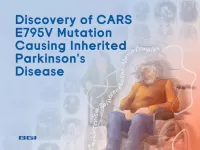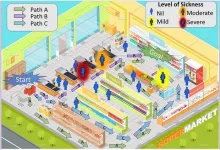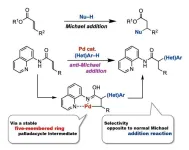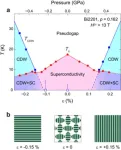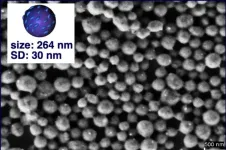(Press-News.org) Weill Cornell Medicine has received $4.2 million to study how the immune system in some people infected with HIV can keep the virus under control, which could lead to novel therapeutic strategies for thwarting or eliminating HIV. Dr. Brad Jones, associate professor of immunology in medicine in the Division of Infectious Diseases at Weill Cornell Medicine, was awarded a MERIT grant from the National Institute for Allergy and Infectious Diseases (NIAID) at the National Institutes of Health (NIH).
The “Method for Extending Research in Time” (MERIT) grant provides outstanding investigators longer-term support for high-risk, high-reward experiments that could lead to major breakthroughs. Fewer than five percent of funded NIH investigators are selected to receive the prestigious award.
“It’s exciting and rewarding to have the importance of the work recognized in this way,” said Dr. Jones. “Not only for me but for the students and technicians and everyone on the team who has been working really hard on the project.”
HIV Persistence—Hiding in Plain Sight
The human immunodeficiency virus (HIV) is elusive and resilient, evading the immune system by incorporating its genetic material into the host’s DNA—hiding in plain sight inside infected cells that persist despite treatment. Although antiretroviral therapy can reduce HIV in the blood to an undetectable level, these dormant reservoirs continue to survive, ready to re-emerge if therapy is interrupted.
To understand how the virus persists in the body, Dr. Jones and his group developed a “patient-derived xenograft” (PDX) mouse model that can replicate the immune system of those rare individuals, dubbed elite controllers, who keep the virus in check—even in the absence of antiretroviral medications.
“What's remarkable is the degree of immune control of HIV that we see in the person is born out in the model,” Dr. Jones said. Both show that much of the HIV hiding in the cells of elite controllers has been banished to gene-poor deserts in the host genome from which the virus is unlikely to be reactivated.
Mapping Where HIV Hides in the Genome
Dr. Jones and his team will use the PDX model to explore whether and how immune cells called killer T cells from elite controllers pressure the virus to bury itself in remote locations. They can also assess whether boosting the activity of these killer T cells enhances HIV exile.
His lab will also explore whether HIV can, in some cases, selectively integrate itself into genes that promote cell survival—giving the virus more time to replicate and spread. “If that’s the case, we have an even tougher problem to solve in our search for a cure,” Dr. Jones said. Determining the types of genes that HIV favors could suggest potential therapeutic targets and different treatment approaches. For example, if HIV is protecting the cells it infects by inhibiting apoptosis (cell death), treatment with drugs that promote cell death could diminish HIV’s advantage and empower the immune system to regain the upper hand.
Building a map of the sites where the virus integrates into the host genome could also allow researchers to evaluate the effectiveness of a therapy based on how well it exiles HIV. “If we can sequester enough of the remaining virus that it’s not going to come back in that person’s lifetime, we’ll be that much closer to a cure,” Dr. Jones said.
END
Prestigious MERIT grant funds research on how the immune system can banish HIV
2024-07-11
ELSE PRESS RELEASES FROM THIS DATE:
Research reveals novel CARS E795V mutation as cause of inherited Parkinson's disease
2024-07-11
According to Science Alert, neuroscientists from Johns Hopkins University have recently discovered a new treatment for Parkinson's disease using an FDA-approved cancer drug. A recent study published in Neuroscience Bulletin reveals the genetic cause of Parkinson's disease. The study discovered that a mutation in the Cysteinyl-tRNA synthetase (CARS) gene (c.2384A>T; p.Glu795Val; E795V) is responsible, offering a new path for prevention and control of the disease. This research was conducted by a team led by Zhang Jianguo, including researcher ...
Narcissism decreases with age, study finds
2024-07-11
People tend to become less narcissistic as they age from childhood through older adulthood, according to a study published by the American Psychological Association. However, differences among individuals remain stable over time -- people who are more narcissistic than their peers as children tend to remain that way as adults, the study found.
“These findings have important implications given that high levels of narcissism influence people’s lives in many ways -- both the lives of the narcissistic individuals themselves and, maybe even more, the lives of their families and friends,” said lead author Ulrich Orth, PhD, of the University of Bern in Switzerland.
The ...
Scientists call for ‘major initiative’ to study whether geoengineering should be used on glaciers
2024-07-11
A group of scientists have released a landmark report on glacial geoengineering—an emerging field studying whether technology could halt the melting of glaciers and ice sheets as climate change progresses.
The white paper represents the first public efforts by glaciologists to assess possible technological interventions that could help address catastrophic sea-level rise scenarios.
While it does not endorse any specific interventions, it calls for a “major initiative” in the next decades to research which, if any, interventions could and should be ...
Mount Sinai secures over $4 million grant from National Institutes of Health to study alopecia areata and atopic dermatitis in people with Down Syndrome
2024-07-11
New York, NY (July 11, 2024) – The Icahn School of Medicine at Mount Sinai is embarking on biomedical research aiming to set new standard-of-care protocols for treating alopecia areata and atopic dermatitis in people with Down syndrome, or trisomy 21.
Emma Guttman-Yassky, MD, PhD, the Waldman Professor and Chair of Dermatology at Icahn Mount Sinai, has been awarded more than $4 million for a five-year National Institutes of Health (NIH) R61/R33 grant to evaluate the long-term safety, efficacy, and mechanisms of medications known as JAK inhibitors in patients with Down syndrome. The medications have been approved ...
How risk-averse are humans when interacting with robots?
2024-07-11
How do people like to interact with robots when navigating a crowded environment? And what algorithms should roboticists use to program robots to interact with humans?
These are the questions that a team of mechanical engineers and computer scientists at the University of California San Diego sought to answer in a study presented recently at the ICRA 2024 conference in Japan.
“To our knowledge, this is the first study investigating robots that infer human perception of risk for intelligent decision-making in everyday settings,” said Aamodh Suresh, first author of the study, who earned his Ph.D. in the research group of Professor Sonia Martinez Diaz ...
An unequal toll of financial stress: Poll of older adults shows different impacts related to health and age
2024-07-11
Inflation rates may have cooled off recently, but a new poll shows many older adults are experiencing financial stress – especially those who say they’re in fair or poor physical health or mental health.
Women and those age 50 to 64 are more likely than men or people over age 65 to report feeling a lot of stress related to their personal finances. So are people age 50 and older who say they’re in fair or poor physical or mental health.
In all, 47% of people age 50 and older said inflation had impacted them a great deal in the past year, and 52% said they ...
One-step synthesis of pharmaceutical building blocks: new method for anti-Michael reaction
2024-07-11
In 1887, chemist Sir Arthur Michael reported a nucleophilic addition reaction to the β-position of α,β- unsaturated carbonyl compounds. These reactions, named Michael addition reactions, have been extensively studied to date. In contrast, the anti-Michael addition reaction, referring to the nucleophilic addition reaction to the α-position, has been difficult to achieve. This is due to the higher electrophilicity of the β-position compared to the α-position. Previous attempts to overcome these difficulties have involved two main methods. The first is restricting the addition position via intramolecular reactions, ...
Urban seagulls still prefer seafood
2024-07-11
Seagull chicks raised on an “urban” diet still prefer seafood, new research shows.
University of Exeter scientists studied herring gull chicks that had been rescued after falling off roofs in towns across Cornwall, UK.
Raised in captivity (before being released), they were given either a “marine” diet consisting mainly of fish and mussels, or an “urban” diet containing mostly bread and cat food.
Every few days the gull chicks were presented with a choice of all four foods in different bowls, to test which they preferred – and all gulls strongly favoured fish.
“Our results suggest that, even when reared on an ‘urban’ ...
Understanding the origin of superconductivity in high-temperature copper oxide superconductors
2024-07-11
Superconductors are materials that can conduct electricity with zero resistance when cooled to a certain temperature, called the critical temperature. They have applications in many fields, including power grids, maglev trains, and medical imaging. High-temperature superconductors, which have critical temperatures higher than normal superconductors have significant potential for advancing these technologies. However, the mechanisms behind their superconductivity remain unclear.
Copper oxides or cuprates, a class of high-temperature superconductors, exhibit superconductivity ...
Shaping the future of polymer nanocarriers
2024-07-11
Scientists have taken a significant step towards the development of tailor-made chiral nanocarriers with controllable release properties. These nanocarriers, inspired by nature's helical molecules like DNA and proteins, hold immense potential for targeted drug delivery and other biomedical applications.
The study, led by Professors Emilio Quiñoá and Félix Freire at the Center for Research in Biological Chemistry and Molecular Materials (CiQUS), highlights the intricate relationship between the structure of helical polymers and their self-assembly into nanospheres. By carefully designing ...
